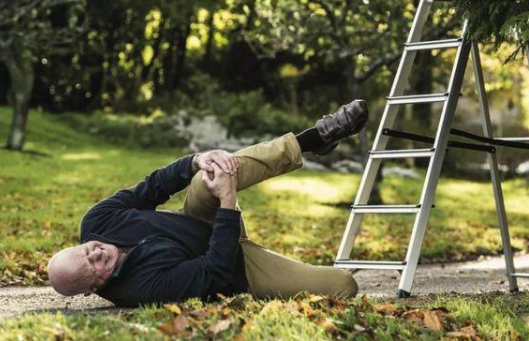中文摘要
老年慢性病患者跌倒的危险因素及相关分析
目的:
老年人是跌倒发生的高危人群,因跌倒致死是老年人的主要死因之一,而合并慢性疾病的老年人跌倒发生率更高,危害性更大。本文旨在研究老年慢性病患者跌倒的危险因素,识别不同因素对跌倒发生的预测价值,为预防老年慢性病患者的跌倒提供理论依据,从而改善他们的生活质量。

方法:
(1)研究对象:纳入2020年1月-2020年6月于吉林大学第一医院干部病房收治年龄≥65岁且至少患有1种慢性疾病的患者182例。
(2)研究方法:根据患者在过去1年内是否有跌倒史分为跌倒组和非跌倒组。收集患者的一般资料、生化指标、内脏脂肪面积、去脂体重、骨骼肌质量、骨矿物质含量、四肢及躯干肌肉含量等体成分数据,并测量超声骨密度值,进行日常生活能力(ADL)、认知功能(MMSE)、老年抑郁(GDS)、营养(MNA)、年龄校正的查尔森合并症指数(a CCI)量表评估。
(3)统计方法:采用SPSS 22.0软件进行数据处理和统计分析,计量资料服从正态分布者用均数±标准差表示,组间比较采用独立样本t检验;否则采用中位数(M,(P25,P75))表示,组间比较采用Wilcoxon秩和检验。计数资料用频数和百分比表示,组间比较采用卡方检验。基于单因素检验结果,对有统计学意义的变量再进行二元Logistic回归分析。绘制受试者工作特征(receiveroperating characteristic,ROC)曲线,获得影响老年慢性病患者跌倒相关因素的最佳临界值,P<0.05认为有统计学意义。
结果:
本研究共纳入182例患者,平均年龄(78.86±8.98)岁,其中非跌倒组117例(64.3%),跌倒组65例(35.7%)。
(1)跌倒组年龄高于非跌倒组(P<0.05),且随着年龄增加老年慢性病患者跌倒的发生率也随之增加。
(2)性别、慢性病数量、多重用药、日常生活能力(ADL)、认知功能(MMSE)、老年抑郁(GDS)、营养(MNA)、年龄校正的查尔森合并症指数(a CCI)、血红蛋白、白蛋白、骨骼肌质量、骨矿物质含量、四肢及躯干肌肉含量是影响老年慢性病患者跌倒发生的相关危险因素(P<0.05),且非跌倒组在身体肌肉含量上较高。
(3)两组慢性病类型对比高血压病是影响老年慢性病患者跌倒发生的相关危险因素(P=0.036),冠心病、糖尿病、慢性阻塞性肺疾病、慢性肾功能不全、脑血管疾病、恶性肿瘤、血液系统疾病、慢性胃炎/消化道溃疡在两组比较中无统计学意义(P>0.05)。
(4)慢性病数量(OR=5.972,95%CI[0.252-5.194],P<0.001)、老年抑郁评分(GDS)(OR=1.087,95%CI[1.005-1.176],P=0.037)是老年慢性病患者跌倒发生的独立危险因素,骨骼肌质量(OR=0.542,95%CI[0.352-0.835],P=0.005)、白蛋白含量(OR=0.791,95%CI[0.6679-0.922],P=0.003)是影响老年慢性病人群跌倒发生的独立保护性因素。
(5)绘制ROC曲线结果显示:慢性病数量曲线下面积(AUC)0.783,P<0.001;临界值2.5(实际取整数3)种,敏感性为0.646,特异性为0.761;GDS的AUC为0.607,P=0.016;临界值19.5分,敏感性为0.554,特异性为0.684;白蛋白含量AUC为0.743,P<0.001;临界值33.75g/l,敏感性为0.607,特异性为0.862。骨骼肌质量AUC为0.745,P<0.001;临界值22.05kg,敏感性为0.786,特异性为0.569。
结论:
(1)老年慢性病患者的跌倒率具有增龄性变化,患有3种及以上慢性病的老年人跌倒的发生率增加。
(2)骨骼肌质量、抑郁评分与老年慢性病患者跌倒的发生有关,并具有一定的预测价值。
关键词: 老年,慢性病,跌倒。
Abstract
Risk factors and related analysis of falls in elderly patients with chronic diseases
Objective:
The elderly are a high-risk group of falls, and death due to falls is one of the main causes of death for the elderly. The elderly with chronic diseases have a higher incidence of falls and are more harmful. This article aims to study the risk factors of falls in elderly patients with chronic diseases, identify the predictive value of different factors for the occurrence of falls, and provide a theoretical basis for preventing falls in elderly patients with chronic diseases, thereby improving the quality of life ofelderly patients with chronic diseases.
Methods:
(1) Research objects: 182 patients who were admitted to the cadre ward of the First Hospital of Jilin University from January 2020 to June 2020 who were ≥65 years old and had at least one chronic disease.
(2) Research method: According to whether the patients had a history of falls in the past year, they were pided into fall group and non-fall group. Collect thepatient's general data, biochemical indicators, visceral fat area, fat-free body weight, skeletal muscle mass, bone mineral content, limb and trunk muscle content and otherbody composition data, and measure the ultrasound bone density value to perform daily activities (ADL), Cognitive Function (MMSE), Geriatric Depression (GDS),Nutrition (MNA), Charson Comorbidity Index (a CCI) scale assessment.
(3) Statistical method: Use SPSS 22.0 software for data processing and statistical analysis. If measurement data obey a normal distribution, it is expressed as mean ± standard deviation, and independent sample t test is used for comparison between groups; otherwise, median (M, (P25, P75) )) means that the Wilcoxon rank sum test is used for comparison between groups. Count data is expressed by frequency and percentage, and comparison between groups is performed by chi-square test. Based on the univariate test results, binary Logistic regression analysis was performed on the statistically significant variables. Draw the receiver operating characteristic (ROC) curve to obtain the best cut-off value of the factors affecting falls in elderly patients with chronic diseases. P<0.05 is considered statistically significant.
Results:
A total of 182 patients were enrolled in this study, with an average age of (78.86±8.98) years, including 117 cases (64.3%) in the non-fall group and 65 cases(35.7%) in the fall group.
(1)The age of the fall group is higher than that of the non-fall group (P<0.05), and the incidence of falls in elderly patients with chronic diseases increases with age.
(2)Gender, number of chronic diseases, multiple medications, ability of daily living scale (ADL), mini-mental state examination (MMSE), geriatric depresion scale (GDS), mini nutritionaal assessment(MNA), age-adjusted Charson's comorbidity index (a CCI), hemoglobin, albumin The skeletal muscle mass, bone mineral content, limb and trunk muscle content are related risk factors affecting the occurrence of falls in elderly patients with chronic diseases (P<0.05), and the non-fall group has higher body muscle content than the fall group.
(3)Comparison of the types of chronic diseases between the two groups. Hypertension is a related risk factor affecting the occurrence of falls in elderlypatients with chronic diseases (P=0.036), coronary heart disease, diabetes, chronic obstructive pulmonary disease, chronic renal insufficiency, cerebrovascular disease, malignant tumors, There was no statistical significance in the comparison of blood system diseases, gastritis/peptic ulcer between the two groups (P>0.05).
(4)The number of chronic diseases (OR=5.972, 95%CI[0.252-5.194], P<0.001), GDS (OR=1.087, 95%CI[1.005-1.176], P=0.037) are chronic diseases of the elderly The independent risk factors for the patient to fall were skeletal muscle mass (OR=0.542,95%CI[0.352-0.835],P=0.005),albumin(OR=0.791,95%CI[0.6679-0.922],P=0.003 ) Is an independent protective factor that affects the occurrence of falls in elderly people with chronic diseases.
(5)The results of drawing the ROC curve showed that the area under the curve of chronic diseases (AUC) was 0.783, P<0.001; the cut-off value was 2.5 (the actual integer was 3), the sensitivity was 0.646, and the specificity was 0.761; the AUC of GDS was 0.607, P=0.016 The cut-off value is 19.5, the sensitivity is 0.554, and the specificity is 0.684; the albumin content AUC is 0.743, P<0.001; the cut-off value is 33.75g/l, the sensitivity is 0.607, and the specificity is 0.862. The AUC of skeletal muscle mass was 0.745, P<0.001; the cut-off value was 22.05kg, the sensitivity was 0.786, and the specificity was 0.569.
Conclusion:
(1)The fall rate of elderly patients with chronic diseases has age-related changes, and the incidence of falls in elderly patients with 3 or more chronic diseasesincreases.
(2)Skeletal muscle mass and depression score are related to the occurrence of falls in elderly patients with chronic diseases, and have certain predictive value.
Key words: Old age, Chronic disease, Fall。
第1章 前言
随着经济与科技的高速发展,人类在衣食住行及社保医疗等多方面的生活条件上得到了明显改善,进而人均寿命也随之延长。研究显示,预计全世界60岁以上的人口将从2013年的8.41亿增加到2050年的20亿以上[1]。
还有报告显示,预计到2030年,美国、欧洲、亚洲、拉丁美洲和加勒比地区的65岁及以上人口所占总人口比例将均提高7%左右[2],2050年美国65岁及以上人口将达到8370万[3]。
而我国目前60岁以上人口接近2.5亿,人口老龄化率为17.86%,预计2030年这一比率将升高至25%[4]。值得注意的是中国80岁以上的人口较其他年龄组增长速度明显加快[5],这种现象被称之为“二阶老龄化”。而世界人口老龄化形势的加剧,势必又会对社会体系带来新的严峻挑战。
随着年龄的增长慢性病的患病率逐渐增加[6],这也是人口老龄化需要面对的不可避免的健康问题之一。慢性病常以起病隐匿、病因复杂、病程长,多与生活方式及环境因素有关,不能自愈和被治愈为特点[7],严重危害老年人的身心健康。
在我国,每年因慢性疾病而死亡的数量高达737.6万,是城乡居民死亡的主要原因[8]。研究显示[9],80%的老年人至少患有一种慢性病,而65-85%的老年人患有两种或以上,后者通常被称为多发病。此外研究发现,65岁以上的老年人平均每年约有三分之一发生跌倒。还有报道指出,65岁以上的老年人85%的骨折及95%的股骨颈低暴力骨折均由跌倒所致[10]。最近一项荟萃分析发现[11],在中国老年人伤害死亡类型中,跌倒居于首位,其死亡率为81.14/10万[95%CI: 67.00/10万-95.28/10万]。跌倒引发的致病、致残、致死率极高,对患者本人、患者家庭及社会造成的损失是不容忽视的。据统计中国老年人跌倒后损伤产生的费用每人每次约为16-3812美元[12],费用跨幅巨大以及跌倒后果的不确定性,导致很多家庭“因跌而贫”。尽管目前国内外在跌倒损伤的相关治疗上,已经取得了巨大的进展,但高骨折风险患者的治疗缺口仍在不断增加[13]。因此对老年人跌倒的预防刻不容缓。老年人群的跌倒是多种因素造成的,但令人欣喜的是,跌倒也是可防可控的不良事件之一。
既往研究表明慢性疾病是影响老年人跌倒的重要危险因素,但这些研究多注重一种常见慢性疾病对跌倒的独立影响[14-16]。老年人往往是多种慢性疾病合并于一身,尤其是高龄群体,多发病的患病率更高,跌倒风险更大,更应引起足够重视。而以往的研究仅将一种特定的健康状况去评估跌倒的危险因素,归因过于局限单一,这显然会导致研究结果的可信度降低。现阶段,将慢性疾病的数量及类型与老年跌倒风险联系起来的相关研究仍然较少,且现有的防跌倒指南并没有指明注重慢性病的数量,因此本研究将以老年慢性病人群为研究对象,通过整体健康状况的衡量来探究该类人群跌倒危险因素的普遍共性。
此外随着时间的推移,人体在器官,组织,肌肉、细胞等各个成分产生的不同速率的退化[17],同时心理、情绪等也会出现不同程度的改变,这在患有慢性疾病的老年人群中体现的更加明显。因此本研究通过老年综合评估、血液生化学指标及人体成分分析仪、超声骨密度仪对患者进行数据采集,应用 SPSS 22.0 软件进行数据处理,研究老年慢性病患者跌倒有关的危险因素,识别不同因素对跌倒发生的预测价值,为制定预防老年慢性病人群跌倒的相关方案提供理论依据。
【由于本篇文章为硕士论文,如需全文请点击底部下载全文链接】
第2章 综述
2.1、 老年人跌倒的流行病学.
2.2、 老年人跌倒的危险因素
2.2.1、 生理因素
2.2.2、 心理因素
2.2.3、 病理因素
2.2.4、 药 物因素
2.2.5、 环境因 素
2.3、 老年人跌倒的干预措施.
2.4 、小结 与展望
第3章 材料与方法.
3.1 、 研究对象.
3.1.1 、 对象来源.
3.1.2、 纳入标准.
3.1.3 、排除标准
3.2、 研究方法
3.2.1 、一般资料收集.
3.2.2、 量表评估方法.
3.2.3 、生化指标采
3.2.4 、仪器检测
3.2.5 、诊断标准
3.2.6 、分组方法
3.2.7 、质量控制
3.3 、统i计学分析.
第4章 结果.
4.1、 老年慢性病患者跌倒组与非跌倒组-般资料比较
4.2 、老年慢性病患者跌倒组与非跌倒组量表及检测结果比较
4.3、 影响跌倒的相关因素的多因素回归分析.
4.4 、老年慢性病患 者独立因素的ROC曲线
第5章 讨论.
5.1 、--般因素对跌倒的影响
5.2 、体成分与跌倒的关系
第6章 结论
(1)老年慢性病患者的跌倒率具有增龄性变化,患有 3 种及以上慢性病的老年人跌倒的发生率增加。
(2)骨骼肌质量、抑郁评分与老年慢性病患者跌倒的发生有关,并具有一定的预测价值。
参考文献.






